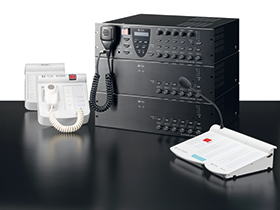

The primary purpose of a voice alarm system (or voice evacuation system) is for the safety of staff, the public, assets and property. The system enables the effective, controlled and rapid evacuation of an area or building during a fire, bomb-alert, industrial accidents, chemical spills, or any other type of emergency by providing clear voice instructions to occupants.
Research has proved that in the event of an emergency, voice messages are significantly more effective at guiding and evacuating occupants to safety, as opposed to other forms of emergency aids like sirens, voice sounders, flashing beacons and so forth.
The secondary benefits of the voice alarm system (VAS) include features such as public address announcements, broadcasting advertisements and background music. All broadcasts (pre-recorded, live or BGM) can be sent to all areas of the site/building, or only to selected areas referred to as zones.
Each VAS is designed and built specifically for each project; typically, no two systems are identical.
A VAS has to work when needed (especially and specifically during an emergency) and is therefore fully monitored at all times. The VAS has a battery-backup, which is fully charged and checked constantly, ensuring continued system operation during a mains power failure. However, due to the continuous load shedding in South Africa, it is recommended that a separate back-up UPS/generator system (with lithium batteries) should be considered.
All TOA’s VA Systems are EN54 Certified and integratable with most fire detection systems (FDS), provided that sufficient relays are provided by the FDS. Integration with a FDS allows the VAS to receive messages from the FDS, which provides the intelligence. The VAS can be configured to include phased evacuation, i.e. the most at-risk areas are evacuated first, while adjoining areas are placed on ‘alert’ with the intent to evacuate after the at-risk areas are evacuated. This allows for better crowd control by reducing the amount of people (and the added risk of injury due to stampeding) in escape routes – this is especially important in multi-storey and high-rise buildings.
Lastly, it is important to take note of the new requirements for both FDS and VAS as prescribed by the updated National Building Regulations and Building Standard Act in SANS10400-T:2020; this updated standard clearly outlines the different types of buildings/spaces of occupancy for which VAS and FDS are obligatory.
For more information, contact TOA Electronics Southern Africa,
| Tel: | +27 11 608 1477 |
| Email: | africa@toasa.co.za |
| www: | www.toasa.co.za |
| Articles: | More information and articles about TOA Electronics |

© Technews Publishing (Pty) Ltd. | All Rights Reserved.